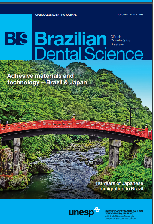Edemogenic test and hydrogen peroxide degradation rate of bleaching gels with different desensitizing agents
DOI:
https://doi.org/10.14295/bds.2018.v21i2.1526Abstract
Objective: The at-home bleaching technique leads to the intimate contact of the bleaching gel with gingival tissues, so this study evaluated the immediate inflammatory response, through the edemogenic test, induced by at-home bleaching gels of 10% carbamide peroxide with different desensitizing agents, the quantification of hydrogen peroxide released and bleaching gels pH. Material and Methods: Forty-eight rats were divided into groups (n=12): CTRL-control group, WP-Whiteness Perfect 10% (FGM Produtos Odontológicos, Joinville, SC, Brazil), OPA-Opalescence 10% (Ultradent Products Inc., South Jordan, IT, USA), and PB-Power Bleaching (BM4, Palhoça, SC, Brazil). For the edemogenic test, all rats received an intravenous injection of Evan's Blue; after 30 min, 0.2 mL of each bleaching gels was injected into the subcutaneous tissue of the rats, and the results of the vascular permeability were assessed after 3 and 6h. The amount of HP released and pH of each product was also determined. Data were submitted to statistical test (p<0.05). Results: At 3h, the PB showed higher vascular permeability than the other groups. At 6h, the PB produced similar vascular permeability than WHI, and higher than OPA and CTRL groups. The OPA group had a higher vascular permeability at 6h compared to 3h; there is no difference in other groups. The PB group had higher HP concentrations than the other groups. Conclusion: In general, the PB caused a more considerable amount of inflammatory edema and higher amount of HP released. This results suggesting that these bleaching gels cause greater aggression in soft gingival tissues that eventually ends up in contact with bleaching products
Keywords
Tooth bleaching; Carbamide peroxide; Hydrogen peroxide; Capillary permeability.
Downloads
Downloads
Published
How to Cite
Issue
Section
License
Brazilian Dental Science uses the Creative Commons (CC-BY 4.0) license, thus preserving the integrity of articles in an open access environment. The journal allows the author to retain publishing rights without restrictions.
=================




























